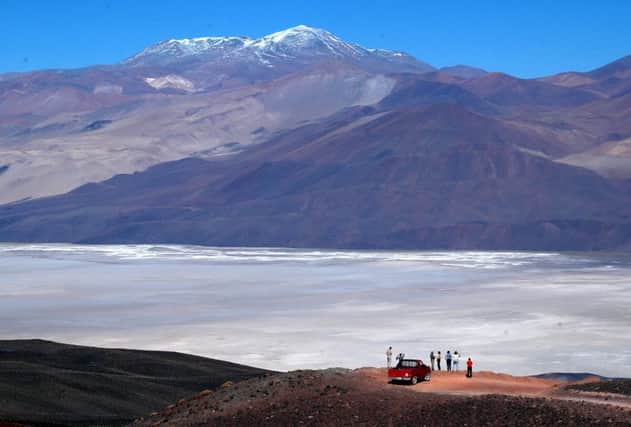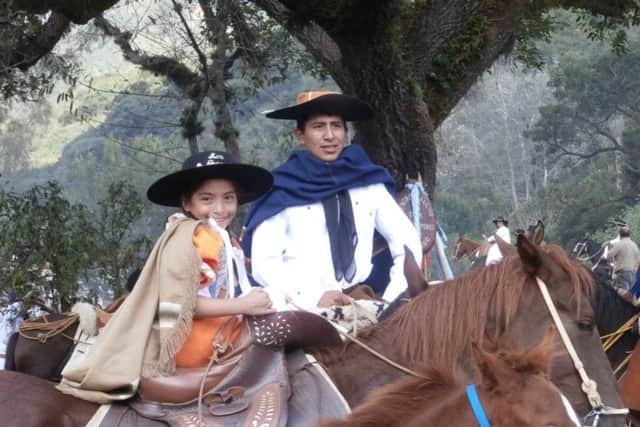Travel: River deep, mountain high in Argentina
This article contains affiliate links. We may earn a small commission on items purchased through this article, but that does not affect our editorial judgement.


It’s a dog’s life – especially if you’re lucky enough to live in Argentina. I’d just sat down for an asado, an Argentinian barbecue, when a sniffing nose appeared from under the tablecloth followed by a pair of pleading eyes. They belonged to Negra, one of three endearingly friendly labradors owned by Fabrizio and Valentina, the Italian proprietors of the beautiful Finca Valentina in Salta, northern Argentina.
Judging from the delicious aromas wafting over from the asado, we were in for a treat, and when the waitress arrived with a plate of sizzling asado de tira (short ribs), Negra lifted her nose and began nudging my arm in gentle expectation. The ribs, sourced from a neighbour’s organic farm, were melt-in-the-mouth perfection, but who was I to resist those puppy dog eyes? With a pat on the head I slipped a morsel into her mouth and an hour later, after a shared feast of steaks, chorizos and black pudding, she rested her nose on my knee, a picture of blissful contentment.
Advertisement
Hide AdAt just over a million square miles, Argentina is a vast country and if time is limited, you’ll need to do a lot of flying to visit the more remote regions. Internal air fares are notoriously expensive, and with routes heavily centralised on the capital Buenos Aires there is little scope to fly directly between regional towns. To reduce costs, it’s worth investing in a South American Air Pass which fixes the price of the distances travelled. The LATAM airlines group has the largest network in South America and is a good option if you’re planning to travel on to other countries.


From Buenos Aires I flew up to Salta in the remote north-west of the country and any preconceptions I had of Argentina being a land of endless pampas grass were quickly dispelled. Its northern reaches brush the Tropic of Capricorn and are covered in tropical vegetation, while to the west, the Andes rise up in a dramatic 4,000-metre wall.
The valleys and plateaux of the Andes are home to some of the country’s most beautiful scenery, and the next morning I joined an excursion organised by Finca Valentina to the Puna, a high-altitude plateau that straddles the spine of the Andes.
However, the first obstacle we encountered was a fiesta. Wherever you travel in Latin America, you’ll stumble across village fiestas which frequently involve long parades on the highway. Drivers have little option other than to park their cars and join in the fun. The parade was headed by a line of elderly ladies in traditional frilly dresses who looked decidedly annoyed when a buzzing drone appeared and hovered over their heads like a giant mosquito. Hot on their heels, long lines of soldiers were goose-stepping to an off-key military band, while bringing up the rear, groups of gauchos dressed in elegant llama ponchos were circling on horseback, ready to display their equestrian prowess. One boy, aged barely five, completely stole the show. In his hand, he carried a rebenque, a traditional gaucho horse whip, and with dexterous twirls and flicks he guided his horse backwards, forwards and sideways with all the grace of a dressage champion.
After an enjoyable hour spent at the fiesta, we continued our journey and entered the Quebrada de Humahuaca, a spectacular ravine that was once an important trading route for the Inca empire. As we climbed in altitude, the vegetation thinned, revealing red, pink and green cliffs of sedimentary rock contorted into swirling loops.
At 3,500 metres, we crossed into the Puna, a mournfully beautiful wilderness of golden grassland grazed by shaggy guanacos, wild relatives of the domesticated llama. In the distance a vast desiccated salt lake, the Salinas Grandes, shimmered in a blinding white mirage. Here, salt miners eke out a living in the harsh conditions and in their spare time turn to sculpture to supplement their income. In a car park surrounded by the sparkling salt fields we stopped at a few ramshackle stalls where weather-beaten men sat hunched over rickety tables carving intricate llama statuettes out of the compacted rock salt, unique mementos from a unique landscape.
Advertisement
Hide AdSouth of Salta, the scenery is scarcely less impressive and the following day we set off for the Los Cardones National Park, a 250-sq mile plateau covered in giant Argentine saguaro cacti. The plateau is flanked by the snow-capped mountains of the Andes Orientalis range and is home to charming whitewashed colonial villages.
At Molinos we stopped at the Hacienda de Molinos, a beautiful 18th-century mansion that belonged to the last Spanish governor of Salta. On a patio under a peppercorn tree we sat down to a lunch of tamales, cornmeal dumplings steamed in leaves and stuffed with spiced beef and vegetables. Continuing our journey, we entered the Quebrada de las Flechas, a lonely valley of bleached sandstone crags eroded into strange arrow-shaped formations by the wind. At sunset we paused at a dusty track and clambered up to a rocky hilltop. A cold wind was whistling and the tops of the crags were flushed pink by the setting sun. The landscape reminded me of one of those brooding sci-fi films set on harsh alien planets and, gazing at an enormous moon hovering above the Andes, I suddenly felt a long way from home.
Advertisement
Hide AdFrom Salta, I flew to Iguazu in Argentina’s far north east. Here, a long finger of jungle sandwiched between Brazil and Paraguay, is Argentina’s equivalent of the Amazon. By the shores of the Paraná, the second-longest river in South America, I checked into the Hotel Puerto Valle, a vast estancia that helps maintain the Estaros del Ibera, a 1,300sq-km tract of wetland which is home to 30 per cent of Argentina’s biodiversity. At dawn, I set out on a boat trip through water channels lined by bulrushes and blue water hyacinths. In the early morning sunshine we passed a two-metre-long black cayman, its bug eyes looking strangely cute for such a voracious predator. A russet-coloured capybara, the world’s largest rodent, sat nearby and watched us with twitching whiskers as we glided by.
On a floating platform by the side of a cobalt blue lake, we stopped for a picnic breakfast.
Our guide, Sebastian, passed around a wooden cup of mate, a bittersweet herbal tea. A soft breeze had blown up, sending ripples across the golden reed beds. After a week or so exploring the Andes, this soothing waterscape provided the perfect counterfoil to the rugged beauty of the mountains and it is these dramatic contrasts that make northern Argentina such a rewarding corner of South America.
Jacada Travel (0203 1317418, jacadatravel.com) offers an 11 night Wine and Wetlands tour of undiscovered Argentina from £4,479pp based on two people sharing Finca Valentina (www.finca-valentina.com) on a B&B basis, with private excursions in Salta with Socompa (www.socompa.com), and full board at luxury wildlife lodge Puerto Valle (www.hotelpuerovalle.com). Also included is a tour of Jesuit missions, a night in Iguazu and tour of the falls, all flights with TAM/LAN (www.tam.com, www.lan.com).